This is what happens when Techland goes to the comic book store: we end up talking about what we picked up. This week, Douglas Wolk, Evan Narcisse, Mike Williams and Graeme McMillan discuss Batman & Robin #14 and Amazing Spider-Man #641.
DOUGLAS: If Grant Morrison was a gunslinger, there’d be a whole lot of dead wannabes. The current storyline in Batman & Robin is hitting for me like no other superhero comic right now–when Morrison gets to work with an artist who really gets him and can pull off mood, he’s unbeatable. Jesus, Frazer Irving is amazing; this is the best work I’ve ever seen him do. When those early pages of the preview went up a few weeks ago without lettering, I wondered if maybe the whole issue was supposed to be silent; his storytelling is so strong that what was going on was pretty clear anyway, and the acting and composition are fantastic, and the coloring–this is the best-colored book on the stands.
GRAEME: Yes, definitely. This is a very pretty book, and I don’t mean that as an insult. The care and attention that Irving brings to his colors (not just in his color choices, although look at the colors in the scene with Gordon being surrounded by Pyg’s Dollotrons, but the textures he leaves on each page, as well) is pretty much unmatched in mainstream comics. I like his figurework and composition, but Irving’s real strength for me is definitely his color work.
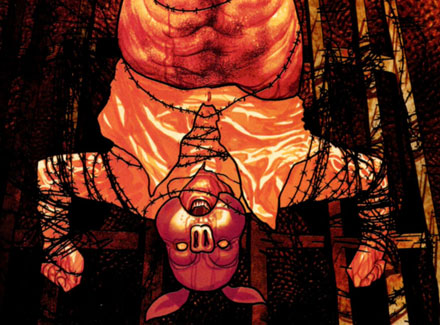
(More on Techland: The Comic Book Club: The Unwritten and Ultimate Avengers 3)
DOUGLAS: A lot of people seem to have picked up on that thing Morrison mentioned about “B&R Must Die” being “Batman R.I.P.” “as farce,” and it does keep bringing up the elements of “R.I.P” upside-down–Gordon, especially, keeps playing the Jezebel Jet role. But I also see it alluding, over and over, to “The Killing Joke”: the whole sequence with Gordon and the Dollotrons is completely a playback of Gordon’s introduction to the Joker’s carnival there.
There’s some crazy symbol-systems being set up here: the goat is the devil is Hurt, the rats are the Bats are the knights. And the Joker is not the adversary (or the Adversary), for once: he’s the wild card. “So who do I know that’s good with serious…?” Well, who’s the most serious (currently active) member of the Bat-family? As RetroWarbird points out, it has to be Jason Todd, at whom this issue is pointing without directly showing him (in the same way the first year of Batman and Robin pointed at the Joker): the kid from Crime Alley who can’t take anything lightly. I bet we see him next time.
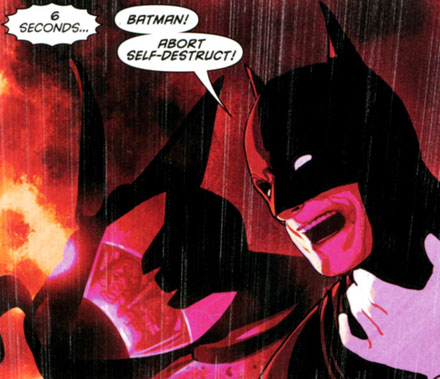
Now, my question is: after the explosion of the Batmobile and the big “DAY 2” caption, how does Dick get to the Batcave (and tell Alfred what to prepare) while Gordon’s still at Park Row/Crime Alley? We also still have to somehow get from here to the eclipse, the “sacrifice of a son/sun” two days from now that we saw at the beginning of last issue…
Line of the week, and already showing up as at least one friend’s AIM status: “Not Botox. Not for work. For work is PCP!” (Although the best actual scene of the week is probably the totally deranged sex scene–three James Bond clichés superimposed on each other–from this week’s Invincible Iron Man.)
EVAN: To me, B&R #15 stands in stark contrast to this week’s Spider-Man. If the core question of superhero comics today is what do we do with the continuity we inherit, then these two comics stand as two starkly different examples.
Morrison’s leaning on events and images from Bat-history that everybody knows: Joker, Robin and a crowbar, Commisoner Gordon tortured with madness. But he upends them and turns them inside out and finds something fresh and lurid there. Hell, the leads of the book can’t even keep up. I love the idea of Joker as chaos hero against the will-less addiction conformity of Doctor Hurt, too. There’s some of Morrison’s chaos magic ideas in there, but they’re fused well with the established Bat-mythos.
It’s not the Batman of O’Neil or Englehart or Miller, and it’s not supposed to be. I think the lesson here is that you can do radical interpretations of your icons if the architecture’s sound. Granted, Morrison’s Bat-epic is somewhat self-contained–it’s not being referenced in a lot of other DCU books–but the new characters and ideas in his work can flow out into the larger organism. (I’m thinking of Paul Cornell using Knight and Squire in that new mini-series, for example.) There isn’t the sense of mandate that seemed to characterize “One More Day” and the other Spidey storylines that led to the reboot. After all, one of the pleasures that superhero comics are supposed to execute better than other genres is longform serial storytelling. A specific creator can either hand off a spiky baton that’s no fun to hold or a sparkly one that glows with every step. Other creators and readers should want to pick up on your interpretation of a character or mythos, not be forced to.
GRAEME: There’s something… creepy, to me, about Doctor Hurt as a character that really helps this storyline work. Yes, he’s all about control, but watching him break Gordon – in a scene that, for whatever reason, reminded me of the headgames and control fetishism of Morrison’s The Invisibles – really made me feel that the storyline is about a lack of control, of things very obviously being OUT of control, and “wrong.” If this is farce, it’s one that’s more than just comedic.
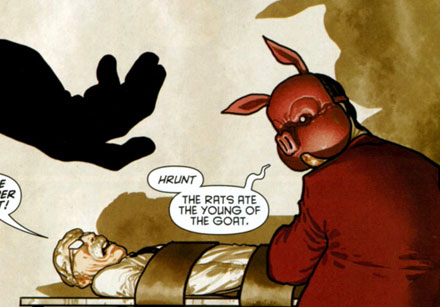
I’m loving the shout-outs to various pieces of continuity (The Killing Joke, RIP, A Death in the Family, etc.) but more for the way in which they’re done – without attention being drawn to them, and upended to gain new meaning – than for any Easter-eggy value in and of themselves. Much like the earlier issues of the series, it feels like Morrison is working out a new (old?) model for how to work within superhero continuity without being strangled by it. Even as he’s doing The Return Of Bruce Wayne elsewhere, I’m struck by how little I miss Wayne in the cowl here; I’ve entirely bought into Dick as Batman, and that’s a pretty impressive accomplishment.
DOUGLAS: I’d go so far as to say that the callbacks are so well executed it often seems like the original stories were foreshadowing or setting up this one! Even when B&R doesn’t work–and that’s not very often–it’s pushing really hard. I wish more superhero comics were this weird and daring.
MIKE: Outside of the art of Frazer Irving, which I could just go on and on about, three things stood out for me in this issue. The first is that Robin, at least Damian, is truly becoming the Boy Hostage. He’s had a real tough time of things since putting on the tights. Morrison is not taking it easy on him. He’s already been shot in the back and had spinal surgery. Now he’s been poisoned and captured by the Joker. If he survives this, and he certainly will, this little egomaniac sociopath is going to have an even bigger chip on his shoulder. We’ve talked about how Morrison occupies his own corner of the DC Universe that no one else really goes near, but this incident between Damian and the Joker can’t be overlooked. Other writers are going to have to take into account that Damian will probably spend the rest of his days trying to murder the Joker. At least he should.
(More on Techland: “Batwoman: Elegy” and “Werewolves of Montpellier”)
The second thing I keep coming back to is: why is the Joker so bent on bringing down the Black Glove and Hurt? The scheme they are up to seems like it’s right in Joker’s wheelhouse. A populace of junkies razing Gotham to get a fix sounds like an anarchist’s fantasy. Is it simply that he likes to be the only show in town? Is that he is just tickled by ‘teaming up’ with Batman and Robin? I personally think it comes down to Pyg. In Pyg, Morrison has crafted a character that is genuinely terrifying. It’s clear that things make perfect sense in Pyg’s twisted, drug-addled mind and that makes him unpredictable and very dangerous. He’s hands down the most interesting Bat-rogue in years.
Finally, why does Hurt keep shooting produce? Is it allusion? Homage to another Bat story that I’m not getting? Foreshadowing? Between the pumpkin and the half-dozen watermelons, I can’t stop thinking about it.

DOUGLAS: On to Amazing Spider-Man. I’ve had mixed feelings about “One Moment in Time”–and I know that some of the Club have… not-so-mixed feelings about it. I do think it’s been a real mistake to defer the “wait, how’d we get from the end of ‘One More Day’ to the beginning of ‘Brand New Day’?” story for a couple of years; the answer isn’t actually all that exciting, and it probably would’ve made more dramatic sense to reveal it earlier. It doesn’t feel like the culmination of the “Brand New Day” period, it feels like something the Spider-office has realized they’re running out of time to get out of the way. And really, I was hoping for something much more clever–at least as clever as the idea in the “Superman 2000” pitch about how to undo the Superman and Lois marriage.
(The only other continuity gap I can think of that’s been deliberately placed and then connected this much later, actually, was the transition between Cerebus #20 and #21–and, as I understand, Dave Sim actually wanted to draw that out longer, but eventually succumbed to people who really wanted to know right away. Which is why we didn’t get to see Sir Gerrik later in the series, when he’d have been more useful. But I digress.)
(More on Techland: The Comic Book Club: Wonder Woman and Action Comics)
That said: Paolo Rivera, man–what a stylish, inventive artist he is, when he gets the chance. It’s a pity that he mostly gets to draw talking heads floating in black space this issue (and that Quesada saves the nice-looking stuff for himself: the Peter-and-MJ montage that “Happy Together” is practically playing over, the big kiss at the end), but he’s been doing really solid work in the rest of this arc.
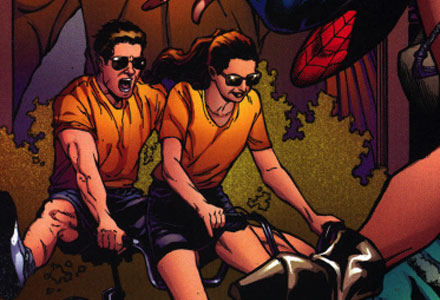
Slightly too cute: is that Tom Brevoort as the hospital aide a few pages before the end?
I will probably get into this a few weeks from now in “Emanata”–I want to do an overview of “Brand New Day” at some point–but I’ve really been enjoying the thrice-monthly Amazing in general: not as a model for the future of superhero comics or anything, but as a thing that’s really fun to read at the gym. I do wish it’d been scheduled and paced better (Amazing three weeks a month, Web the fourth week, would that have been so hard to pull off?), but there’ve been a lot of entertaining storylines and solid work over the last couple of years. And I especially like the bonus features–most of all the Stan Lee/Marcos Martin “Sunday strip” that’s been running for the past few months. Martin’s one of those artists who’s not exactly high-profile, but the more latitude he gets the more interesting his work is, and he’s really been cutting loose on this feature.
EVAN: Man, I hated this comic. Now, I should start by saying that I’ve been one of those “Brand New Day” objectors. I basically took the overriding logic of the Spider-reboot as a tacit admission by Marvel PTB that they couldn’t write a married Spider-Man, that there weren’t enough story possibilities with the Spider-Man they inherited. (And I really thought that the Spidey secret identity reveal during Civil War was a incredibly bone-headed decision.) I’ve peeked at a few issues of Amazing in the past few years and, while some have been good, I never felt like the new status quo of Peter’s personal life generated the excitement or possibility that it was supposed to.
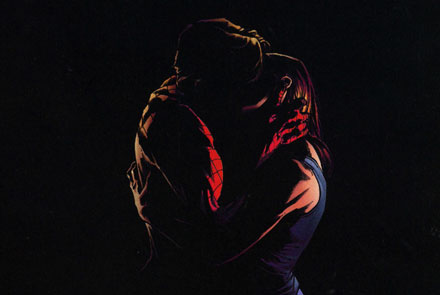
But I don’t want to talk continuity minutiae. Rather, it’s what the Spidey plot twists and events stand for that bother me. The Spider-Man stories that led to the painted-in-a-corner dilemma–Civil War, “One More Day”–were on Quesada’s watch. And this storyline’s felt like a poor attempt to address the decision-making process: let’s get the Marvel Universe’s potentates together so they can decide what to do about Spider-Man. (Just like we did!) Ultimately, it felt like just so much blathering on with empty platitudes. Spider-Man’s “the best of us”? Well, doesn’t he deserve better? Peter yanks MJ in to the magic don’t-forget bubble and it turns out to be the wrong thing in two ways. It screws his relationship with MJ in the text and metatextually feels wrong. It’s a super-selfish move for a character who’s embraced selflessness no matter what it’s cost him. The whole thing just feels muddy and self-indulgent.
It reminds me so much of what bothers me about superhero comics nowadays: creators who can talk the high-falutin’ talk about what makes a character but can’t execute it.
That sign-off at the end of the issue’s main story is laughably contradictory to me. A nod to the guys whose stories have your decisions have invalidated? Really?
That said, I agree with Douglas on the Marcos Martin love. Gotta find that Batgirl: Year One series somewhere…
GRAEME: Yeah, color me one of the guys with less-than-mixed feelings about “One Moment In Time.” It’s not because I’ve disliked the post-One More Day set-up for the character and series, because I think Spider-Man’s been more interesting and enjoyable to me as a reader in the last three years than he’d been for decades previously, but because “One Moment In Time” feels entirely unnecessary – A story needed only to wrinkle out continuity concerns created by a story created to create new continuity? It’s so backwards-looking and fanboyish – and so utterly shoddily done. I’ll agree with Douglas that Paolo Rivera’s art is very nice (although this issue is the weakest of his efforts on the story, I have to say), but the writing is just appallingly weak. Joe Quesada’s dialogue tries to imitate how regular people talk, but it comes out as soap opera cliche, and the final revelations about the new status quo’s big unknowns (How did Peter’s identity become secret again? What happened on his wedding day to Mary Jane?) really, disappointingly, mundane (and vague – The “Yeah, so we’re created a magic science virus that’ll make people forget and erase all the data” fix in this issue was comically shoddy).
Again, I’m with Douglas that it should’ve been done earlier, and I can’t help but wonder if it was MEANT for much earlier. That last page, with Spider-Man narrating that it “feels like a Brand New Day!,” even though that branding hasn’t been used for more than two and a half years, was jarring.
(More on Techland: The Comic Book Club: X-Men, Superman and Parker)
MIKE: I too, hate everything! Loud noises!
When Mephisto showed up a couple of years ago, I checked out. I’ve been sort of waiting in the wings and scanning every fifth or sixth issue of Spidey to get good again. Spider-Man leading up to Civil War was a good time to be a Web-Head fan. I didn’t even mind the Iron Spider suit. But then One More Day rolled along, and it wasn’t that I was offended by the almost casual way decades of story were tossed aside–I just didn’t care. Spider-Man without MJ doesn’t bother me. Peter Parker has so many facets of his personality that humanize him, what’s one less?
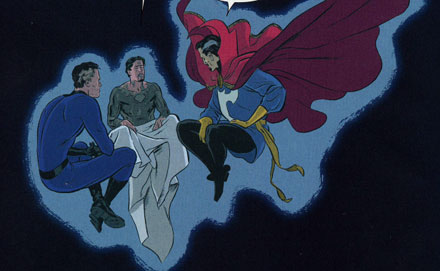
My point is that I agree that this story seems unnecessary, and I certainly won’t be re-reading it any time soon. One day, when I start reading Spidey again, I’d sooner hit the wiki articles rather than read the back issues to catch up. And I have no doubt that I will read Spider-Man again. Did you all read the recent “Shed: story-line with the revamped Lizard? Maybe it was just Bachalo’s art (I love it, but I know it’s not for everyone), but that was what I want from my Friendly Neighborhood. Slugfests, self sacrifice, a scientist’s mind behind the mask, and a hero that is protecting the city again. Tony, Reed, and Doc Strange having a seance for pages on end does not a Spider-Man comic make.

